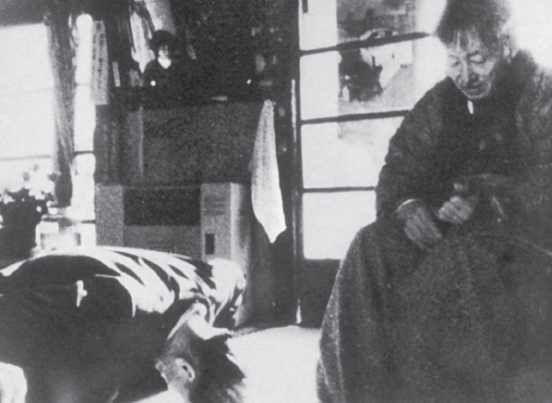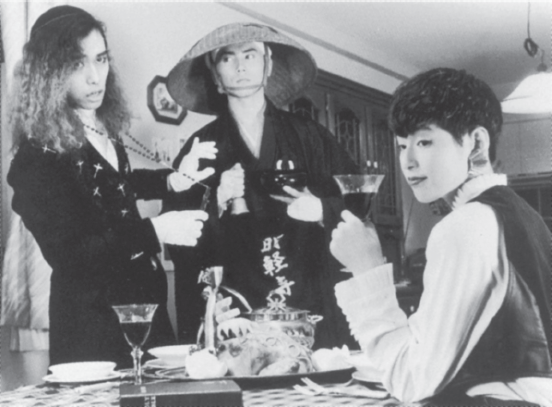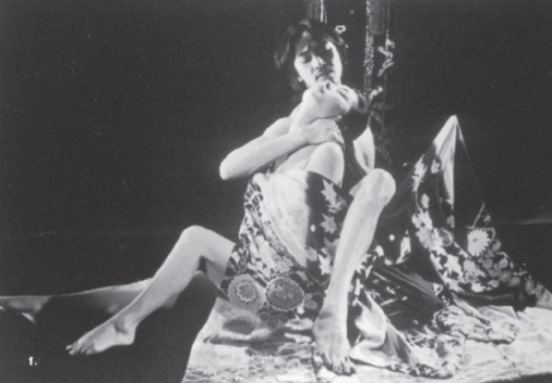The major characteristic of 1980s Japanese cinema is that the studio system gradually became totally nonfunctional. This became clear in film production, distribution, and exhibition. In 1961, this system had six studios that could make 520 films, but twenty-five years later in 1986, only three studios produced a mere twenty-four films. The block-booking system—in which a film could open simultaneously in theaters devoted to that studio in every town and village in Japan—was simply not possible any more, and the previously standard system in which major studios would use big-budget pictures to keep their grip on the industry had ceased to function.
Nikkatsu changed its name by writing it in the Hiragana syllabary instead of the Chinese characters they previously had used. The studio pursued a rationalized management system; but in 1981, it abolished the exclusive producer system. The spread of video for home use and the emergence of adult video as a genre brought an end to Roman Porno. In 1985, they inaugurated a new line—Roman X—shifting direction to the production of even more hardcore sex films, but this desperate ploy did not achieve anything and was like pouring water onto burning rocks. In 1988, as a final step, they abandoned the Roman Porno films that had been the mainstay for sixteen years and embarked once more on making films for a general audience under the name Ropponika. In less than a year, however, they were forced to cease production again. Nonetheless, Nikkatsu had done more than any other major studio to develop new directing talent and to train the next generation of technical staff. During the 1980s, such directors as Ikeda Toshiharu, Nakahara Shun, Nasu Hiroyuki, Kaneko Shūsuke, Ishii Takashi, Negishi Kichitarō, and Morita Yoshimitsu started their careers at Nikkatsu.
Shōchiku, Tōei, and Tōhō did not produce new directors in the same way as Nikkatsu. Shōchiku in particular spent the 1980s simply producing Yamada Yōji’s It’s Tough Being a Man over and over again, covering the same ground without creating anything new. Tōei and Tōhō did not have comparable salable properties and relied on the rickety support of films that could mobilize mass audiences to buy advance tickets. Tōhō followed the success of Moritani Shirō’s Mt. Hakkoda (Hakkodasan, 1977) by repeatedly releasing epics that similarly praised heroism and had a hint of pathos. These works included Matsubayashi Shūe’s The Imperial Navy (Rengō kantai, 1981). Every August—the anniversary of the end of the war—with dreary regularity, Tōei had Masuda Toshio direct works like The Battle for Port Arthur (Nihyaku-san kōchi, 1980) and The Great Japanese Empire (Dai Nippon Teikoku, 1982). These films tried to stir up a sense of nostalgia for the military strength of the Japan of old.
The collapse of the studio system meant the loss of a place for the training and transmission of technical and production skills in actual shooting in the fields of cinematography, lighting, sound, and art. In 1989, during the production of Zatōichi, with the star Katsu Shintarō himself directing, a horrible event occurred in which a fight trainer died when a real sword was used rather than a prop sword. This heart-breaking incident not only showed the incapability of the assistant director to establish and maintain safety protocols on set but also revealed how far the level of production skills had dropped in jidaigeki.
The system of program pictures was, however indirectly, supported by the world of Pink Film. Even with unbelievably low budgets, awful production conditions, and the contempt of critics, Pink Films continued the radical activity that started in the 1960s and still provided outstanding new directors opportunities to direct their debut thirty-five-millimeter films during the 1980s. Directors like Kurosawa Kiyoshi and Suo Masayuki are two prime examples. Because of their grounding in Pink cinema, directors like Zeze Takahisa, Sano Kazuhiro, Satō Hisayasu, and Satō Toshiki came to be called the “Pink Film nouvelle vague.”
The dissolution of the studio system provided chances for corporations that previously had no direct connection to cinema to enter the film world. The first was Kadokawa Publishing, which made itself known in the late 1970s with large-scale productions with massive advertising budgets. In the 1980s, Kadokawa was followed by television stations, trading companies, and retail companies. The spread of video, cable television, and satellite broadcasting provided film images with possibilities for secondary and tertiary use. This finally led to media-image corporations’ entry into film production seeking the rights to video software.
Decisive changes in how movies were shown emerged in the 1980s. Repertory cinemas (meigaza), usually affiliated with major studios and their program pictures, began to close up one after another. In place of these repertory cinemas, mini-theaters appeared, with seating capacities of around two hundred, in addition to cinema complexes, which combined numerous small screening rooms. Such theaters were not a part of the block-booking system, so as a happy result, they had the ability to choose strongly individual films and could screen them in their own theaters without concern for a repertory schedule imposed by a studio or distributer. During this decade, in Tokyo, it was possible to watch films ranging from experimental European art-house fare to films from previously unfamiliar Asian countries, far exceeding what could be seen even in Paris or New York. For these ten years, Tokyo was transformed into a film center where it was possible to see the greatest variety of films in the world. This rapid increase in mini-theaters allowed unprecedented opportunities for new talent to shoot new and unique kinds of films.
New film directors arrived in the world of cinema from many different fields previously unimagined. I have already described Nikkatsu and Pink Films. Additionally, Hara Kazuo (1945–) and Takamine Gō (1948–) emerged from the world of independent filmmaking in the late 1960s. Where Ogawa Shinsuke was committed to filming documentaries based firmly in farming communities, Hara was committed to the standpoint of the individual, to an extent that at times he unavoidably aroused hostility in the people on whom he focused and developed his own brand of “action documentary.” But this process produced powerful films like The Emperor’s Naked Army Marches On (Yukiyukite shingun, 1987) and A Dedicated Life (Zenshin shōsetsuka, 1994). Takamine Gō made Untamagiru (1989)—named after a mythical character—in his native Okinawa with dialogue almost entirely in the Okinawan language. When the film first opened, Japanese audiences needed subtitles in the Japanese language to understand it. The 1980s was a time when many regions around the world produced films in minority languages, including Wales, Brittany, and Taiwan. Takamine’s film took a traditional picaresque tale about righteous bandits handed down in Okinawa and, being in the Okinawan language, it was a brilliant counterstatement of Okinawan cultural identity against the mainstream narrative celebrating the reunion of Okinawa with Japan in 1972. This is a perfect example of what Fredric Jameson called “national allegory.”

The Emperor’s Naked Army Marches On (dir. Hara Kazuo, 1987).
From the eight-millimeter independent film movement of the 1970s came directors Ōmori Kazuki, Nagasaki Shun’ichi, Imazeki Akiyoshi, Tezuka Makoto, and Yamamoto Masashi. They were not as radical in terms of methodology as the previously mentioned Hara Kazuo or Takamine Gō, and the content of their films was not so closely tied to their own personal lives as with these two. But their independent films were richly narrative and even at that stage showed a strong affinity with mainstream feature films. The magazine PIA, Tokyo’s biggest entertainment guide, hosted a film festival and supported their activities. Ironically, the production of the eight-millimeter film stock that gave birth to these films largely ceased in the 1980s and was being replaced by a new genre—video.
In the late 1980s, the economy was unusually prosperous—the so-called bubble economy—and one after another, celebrities from a variety of fields were pulled into making films. Innumerable musicians, actors, writers, painters, and former professional boxers were mobilized, but few of these people ever made a second film. The number of those who made works significant for film history was even fewer: only comedian Kitano Takashi, Kabuki actor Bandō Tamasaburō, and actor Takenaka Naoto could be counted among them. These three artists became even more visibly active in the indies scene of the 1990s.
Several famous directors who had been vibrant and active in the 1960s, but who were pushed into silence during the 1970s, reappeared in the 1980s to produce extraordinary works. Kurosawa Akira presented large-scale works like Kagemusha (1980) and Ran (1985), with an even more highly polished lyricism in his style. With Dreams (Yume, 1990), Kurosawa cooperated with his old friend and director of kaijū movies, Honda Ishirō, which allowed Kurosawa to fully realize his long-held love of painting. Kurosawa was referred to with the exalted term of respect “emperor,” but this naming also indicated his isolation within the difficult contemporary conditions of film production in the 1980s. Many young directors and critics who were then competing to make a place in the film world were conspicuously unimpressed with Kurosawa. Kurosawa was furious with the lack of understanding at home and had to seek out producers in America and France.
Suzuki Seijun’s return was a contrast to the isolation of Kurosawa. This action filmmaker, who had been summarily fired by Nikkatsu in 1968, scored an astonishing comeback with the films he made inspired by the erotic and fantastic spirit of Izumi Kyōka: Zigeunerweisen (1980), Heat-Haze Theater (Kagerōza, 1981), and Yumeji (1991), which was named after the Meiji ukiyo-e artist Takehisa Yumeji. These three interrelated works demonstrated the most sophisticated aesthetic sensibility achieved by anyone in postwar Japanese cinema, combined with a baroque spirit at its most extreme. Kyōka was the powerful writer who had forged the shinpa-esque world at the foundation of Japanese cinema. Seijun, by focusing on those grotesque and fantastic aspects that had been suppressed in the conventional presentation of Kyōka in Japanese theater and film, succeeded in making what he himself called “film Kabuki,” a site of overflowing nostalgia and decadence.
Heat-Haze Theater (dir. Suzuki Seijun, 1981).
Other directors who resurfaced included Yoshida Yoshishige, with Human Promise (Ningen no yakusoku, 1986), and Matsumoto Toshio, with Dogura Magura (1988). Within Japanese cinema, they constituted what Jean-Marie Straub and Danielle Huillet once called the “people who do not compromise.” They took the themes that they had created in the experimental season of the late 1960s and, in the 1980s, continued this by making films that deepened and expanded these themes. Terayama Shūji adapted Gabriel García Márquez’s One Hundred Years of Solitude as Farewell to the Ark (Saraba hakobune, 1982), shifting the setting to Okinawa. Then he died, leaving the world after forty-seven years of turbulent troublemaking.
The documentarist Ogawa Shinsuke judged that the farmers’ struggles against Narita airport, which he had been involved with since the 1960s, had reached a level of settlement and moved with his staff to a village in the mountains of Yamagata prefecture. There they made “Nippon”: Furuyashiki Village (Nippon koku: Furuyashikimura, 1982) and Magino Village: A Tale (1000 nen kizami no hidokei: Maginomura monogatari, 1987). Both are gentle works that look steadily at the society of rural communities using the measuring stick of immense spans of time. They were created by standing at the crossroads of an ethnographic imagination and a reflexive historical critique of modern Japan. After making these films, Ogawa passed away, but his spirit lives on in the Yamagata Documentary Film Festival, which he helped to create.
I next touch on a few new directors who became active during the 1980s.
Sōmai Shinji (1948–2001) emerged with films that featured young boys and girls as protagonists, including Sailor Suit and Machine Gun (Sērā fuku to kikanjū, 1981), P. P. Rider (Shonben raidā, 1983), and Typhoon Club (Taifū kurabu, 1985). He had the most aggressive and radical style of any of the new directors who emerged during this period. In single scenes without any cuts, Sōmai kept the camera moving incessantly, presenting unexpected transformations of hazy, noise-filled spaces before audiences. Japanese cinephiles believed that these films, with such violently anarchic techniques, embodied new principles that went beyond André Bazin’s thesis of “découpage through spatial depth”1 from thirty years ago, and to them, this gave Sōmai a sublime cult-like status.
Itami Jūzō (1933–1997), the son of Itami Mansaku the writer and director who had been active in the 1930s, also had experience as an actor in Hollywood during the 1950s. After meticulous preparation, he debuted as a director in 1984 with The Funeral (Osōshiki). The film garnered great attention that year, with its alternately cynical and humorous depictions of a contemporary Japanese family carrying out a funeral. What exerted a decisive influence on Itami was the theory of cinematic quotation, which was the latest trend among film critics at the time, with extensive borrowings from contemporary French thought. The Funeral was full of hidden references to film history, quoting everyone from Dreyer to Ozu Yasujirō. Of course, this could not last, and before long, Itami abandoned this methodology. In the 1990s, Itami’s fellow filmmakers, Kurosawa Kiyoshi and Suo Masayuki, would have to make a strong effort to break free from the burden of this reified ideal rooted in memories of film history.

Fancy Dance (dir. Suo Masayuki, 1989).
I next describe the beginnings and some of the movements in the 1980s of Japanese animation that would later gain popularity throughout the world under the name “Japanimation.” The first postwar feature-length anime is said to be The Tale of the White Serpent (Hakujaden) created in 1958 by Tō’ei dōga, Tō’ei’s animation department. Then, in the 1960s, Tezuka Osamu’s Mushi Production made several works, and in 1977, Masuda Toshio directed Space Battleship Yamato (Uchū senkan Yamato) causing a huge boom. Whatever its successes, up until the 1980s, anime never went beyond being considered a genre exclusively for young people. In that sense, the sensational appearance of Miyazaki Hayao in the 1980s was important because it brought adults into the world of anime. Works such as Nausicaä of the Valley of the Wind (Kaze no tani no Naushika, 1984) and My Neighbor Totoro (Tonari no Totoro, 1988) featured stories that mixed themes of ecology and nostalgia. Miyazaki’s characters flew around freely—the kind of action difficult to achieve in a conventional film—restoring a utopian sensibility to screens that had long before disappeared from literature and film. In the 1990s, his name gained worldwide recognition, and with Princess Mononoke (Mononoke hime, 1997), he set a new record in Japanese film history for distribution revenue.
For representative new directors of the 1980s, we can mention Yanagimachi Mitsuo, Nakahara Shun, Ōmori Kazuki, and Morita Yoshimitsu. Yanagimachi made two profoundly thoughtful films based on the works of the writer Nakagami Kenji. In particular, Fire Festival (Himatsuri, 1985) was praised as a work that looks back at Shinto worship of mountains and same-sex eroticism in its depiction of a mass-slaying incident. Nakahara was a director who emerged out of Nikkatsu Roman Porno, making him part of the last generation to experience the Japanese studio system. His constant theme is the fleeting, transitional quality of youth and the rites of passage that punctuate it. We can see the essence of his orientation in two films: Make-Up (Meiku appu, 1985) and The Cherry Orchard (Sakura no sono, 1990). The former, inspired by Federico Fellini’s La Strada (1954), presented a story of a stripper and an intellectually disabled boy, while the latter took up the production of a graduation play at a girl’s high school. Ōmori’s style was founded on the sentiments of nostalgia and regret, but once he broke with the past, he opened up new pathways for Tōhō’s idol films. Then, in the 1990s, he made several films to help revive the Godzilla series, and gradually, he moved closer to being considered a filmmaker for the Japanese people. Morita, with his light humor and philosophical resignation, garnered attention with a floating style that seemed to be completely free of gravity. Family Game (Kazoku gēmu, 1983) deftly crafted images of the impulses toward death and chaos hidden in the everyday lives of contemporary Japanese. And Then (Sore kara, 1985), based on the Meiji writer Natsume Sōseki’s novel, successfully captured the themes of ennui and lethargy within a contemporary context.
During this decade, the most important film actor was Matsuda Yūsaku. He appeared in Kadokawa blockbusters in the late 1970s, and after that, he gained attention for his portrait of an ascetic and eccentric killer in Murakawa Tōru’s action films. In works like Seijun’s Heat-Haze Theater and Morita’s Family Game, he played the role of the educated idler to much critical acclaim. An action film he directed himself, A Hōmansu (1986)—the title is a combination of the word “ahō” for “fool” and the word for “performance”—could be described as a perversely mannerist gang film.
When Matsuda died at the age of thirty-nine in 1989, young Japanese film fans felt that everything had ended, just as many had felt when James Dean died. The same year, however, was also a time of beginnings: the directors Kitano Takeshi, Zeze Takahisa, Sakamoto Junji, and Tsukamoto Shinya all debuted that year. They seemed to emerge at the forefront of the Japanese film world when Matsuda died, like the changing of the guard. This raised the curtain on Japanese film in the 1990s.



